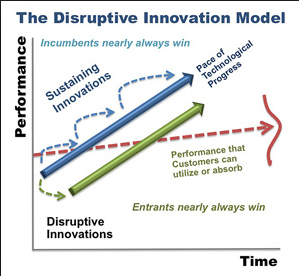-
Jacklin Altman wrote a new post on the site MIS4596 – Section 3 Spring 2015 9 years, 8 months ago
In light of our learning about disruptive innovation and reading about companies like Apple who have used it to their advantage, I found an article claiming that disruptive innovation is not a strategy and […]
-
Jacklin Altman wrote a new post on the site MIS4596 – Section 3 Spring 2015 9 years, 9 months ago
With our own progress reports coming due each week, I thought I would share this article that has some pointers for how to effectively communicate the status of a project. The author, Rob Redmond, states that to write an excellent status report you need to understand the three components of status, how to write brief details, and what key data is needed by management.
He describes the three components of status as:
Overall: The overall project health
Milestones: Major accomplishments with accompanying dates
Issues: Obstacles to successful project completionHe then goes on to explain the concept of “brief details,” in which he suggests that when reporting a status you:
Use bullet points instead of prose
Avoid unnecessary titles
Shorten sentences as much as possible
Avoid adverbsLastly, key project data that should be communicated includes:
Project Name
Overall health (red, yellow, green can be used here)
Current completion (in %)
Expected project completion
If you are ahead/behind schedule, if so, how much
Issues you faceDo you agree with the author’s three-point structure for status reports? What do you think goes into writing a good status report? How have your status reports evolved after taking MIS 3535?
-
I agree with the author’s three-point structure for status reports. All status reports should include the overall project health so that others can get a sense of whether the project is going well or not, right away. Major accomplishments should be tracked to assure stakeholders that the work is being done in a timely fashion and can be very encouraging. Issues should definitely be communicated because if the issues are unknown to others, there is no way they will know if there is something that they can help with.
A good status report should definitely use the green, yellow, red approach to illustrate the health of the project so that it draws attention to what needs to be focused on and less attention to what doesn’t. A good status report should also be written concisely. After taking MIS 3535, I’ve gotten better at writing status reports. I am briefer in the details of what is happening throughout the various phases of the project and am elaborating on details that may be unclear.
-
-
Jacklin Altman commented on the post, Effective Elevator Pitches, on the site 9 years, 9 months ago
I agree with Ennico in that a good elevator pitch needs to get the other person interested, needs to convey the main point of the idea being pitched, and should absolutely start with an intro. I think that a good elevator pitch should be short and sweet, spoken clearly and with a confident voice, and it should have anywhere from 1 to 3 “big…[Read more]
-
Jacklin Altman commented on the post, Progress Report for Week Ending, September 22, on the site 9 years, 9 months ago
I definitely think there is a growing emphasis on good presentation skills both in classrooms and in boardrooms. I have noticed that a majority of my upper-level courses at Temple have all had presentation components that were critical to success in that class, which I think closely mirrors how the ability to present well is critical to success in…[Read more]
-
Jacklin Altman wrote a new post on the site MIS4596 – Section 3 Spring 2015 9 years, 9 months ago
In class we talked about being innovative versus being creative. An article I read cites Shawn Hunter, author of “Out Think: How Innovative Leaders Drive Exceptional Outcomes,” who discerns the two as follows:
“Creativity is the capability or act of conceiving something original or unusual while innovation is the implementation or creation of something new that has realized value for others.”
The article goes on to discuss how creativity does not necessarily mean innovation, though it can lead to it. In a brainstorming session where ideas are flying around, that’s creativity. It isn’t until some value-driving idea is actually implemented that innovation sets in.
Shawn Hunter also chastises businesses for trying to create creativity on demand, by forcing employees into brainstorming sessions instead of focusing on building innovative processes and products. He claims that innovation doesn’t have to be the next big thing, it can simply be a tweak to a current process that makes the business operate better. He also states that it’s crucial that a business and its entire culture do everything possible to foster innovation in the workplace. The article cites the creation of the Starbucks Frappuccino as an example of innovation. Originally, the idea was rejected by company leaders. It wasn’t until the product was quietly made and sold to customers that it became a hit and was officially introduced into the product line.
Do you think that innovation and creativity necessarily need to go hand in hand? Can one exist without the other? Can one be successful without the other? In your experiences in the workplace, does management tend to focus more on innovation or creativity?
-
Innovation and creativity do not necessarily need to go hand and hand. Businesses should definitely make sure that they find their proper balance of innovation and creativity because both are needed in order to be successful. However, every business has to make sure that they set themselves apart by focusing on its strengths in comparison to its competitors. Some businesses are better at being innovative than others, while some businesses are better with creativity. If a business is not great at being innovative and its competitors are and they have the same level of emphasis on innovation, the business that is not as innovative will sink. The same is true for creativity.
Creativity can definitely exist without innovation and vice versa. New ideas can be generated everyday but it does not necessarily mean that the business is going to implement it. A company can implement something new that its competitors already have implemented before them, which lacks creativity. In my experience, management focuses more on implementation than creativity because management seems to favor some people’s ideas more than others. However, management does focus on tweaking existing processes to find ways to do things better for everyone, which is the innovation piece.
-
I believe that creativity and innovation are two separate entities. Creativity is more of an art approach to something. It uses design to catch the eye of a consumer. Creativity makes a product beautiful or more attractive. Innovation is more developing a new method of doing something that no one has thought of yet. When I think of innovation it is simple, yet extremely useful.
Both creativity and innovation go hand in hand. Although able to stand alone, both are best used when put together. With a mix of the two, the creation of a new product or idea can far surpass any standard that already exists. For example, when designing a new car. If the engine is a new innovative idea, a consumer may not see the innovation without a creative outside design. Creativity and innovation should be intricately intertwined to create outstanding ideas.
-
Using the article’s definition of creativity and innovation I would say creativity can exist without innovation but innovation needs creativity. Someone can come up with many creative ideas but without action they remain that, ideas. Also, not every creative idea is innovative. I usually think of innovative ideas as not just implemented, but somewhat successful. I don’t believe people would call an idea that caused a business to go out of business innovative, but it could have been creative.
I think an issue with being innovative businesses have is trying to force it as he discusses. When you sit a group of people in a room and say, ok innovate, you get people so focused on coming up with a new, innovative solution that they do not come up with any innovations at all. I agree with Shawn Hunter that brainstorming sessions are not always the best strategy to trying to employ when trying to think of a solution. I sat in many brainstorming sessions as an intern where the person running the session did not employ the best practices we discusses in class and all they led to was awkward silence and no solutions. When you put so much pressure on people to be creative or innovative they will self edit before they say anything.
In my experience management looks for innovation because they want actionable ideas. The next question after ‘we could do ____’ is always ‘how would we do that’. They also tend to dismiss the idea if you don’t at least have a starting point.
-
-
Jacklin Altman commented on the post, Progress Report for Week Ending, September 22, on the site 9 years, 9 months ago
Sending content ahead of time definitely has value, and it’s something i’ve never considered either. I think it’s tough in a classroom setting though, for a number of reasons. When doing school presentations, we’re pretty programmed to do exactly what the professor tells us, and I know that i’ve personally never had a professor to tell me to send…[Read more]
-
Jacklin Altman and
 Amanda M Rossetti are now friends 9 years, 9 months ago
Amanda M Rossetti are now friends 9 years, 9 months ago -
Jacklin Altman and
 Brittany M Cougle are now friends 9 years, 9 months ago
Brittany M Cougle are now friends 9 years, 9 months ago -
Jacklin Altman and
 Arren Soroko are now friends 9 years, 9 months ago
Arren Soroko are now friends 9 years, 9 months ago -
Jacklin Altman and
 Dominic P Lyate are now friends 9 years, 9 months ago
Dominic P Lyate are now friends 9 years, 9 months ago -
Jacklin Altman changed their profile picture 12 years, 6 months ago
Connect and innovate with an elite information systems program
Footer
MANAGEMENT INFORMATION SYSTEMS
Fox School of Business
Temple University
210 Speakman Hall
1810 N. 13th Street
Philadelphia, PA 19122




I agree with the idea. Although it is possible to create a culture of innovation and creativity, it is flawed logic to assume that an organization can plan on disrupting markets on call. What can be done is to cultivate the employees mindsets and approaches and provide them with the resources and empowerment necessary to create new things. Those creations, even if they take place, aren’t guaranteed to be monetized. In plain terms, you can only lead a horse to the water.
I agree with Mohamed that some companies will be more innovative than others, and that directly depends on their culture. However, even though Steve Jobs didn’t intend to redefine the music industry, that’s because it’s really difficult to determine if a product is going to be successful when the general public doesn’t even know they need it. He knew the iPod’s design, bundling package (software with hardware), music store and business model were unique and extremely innovative, but other than making predictions based on some preliminary research, you will never know a products’ success until you launch it. I don’t think that disruptive innovation is a sustainable business model because that would require predicting the future. However, I think you can strive for sustaining extreme innovation, which will most likely disrupt a market eventually if it is successful in creating that culture.